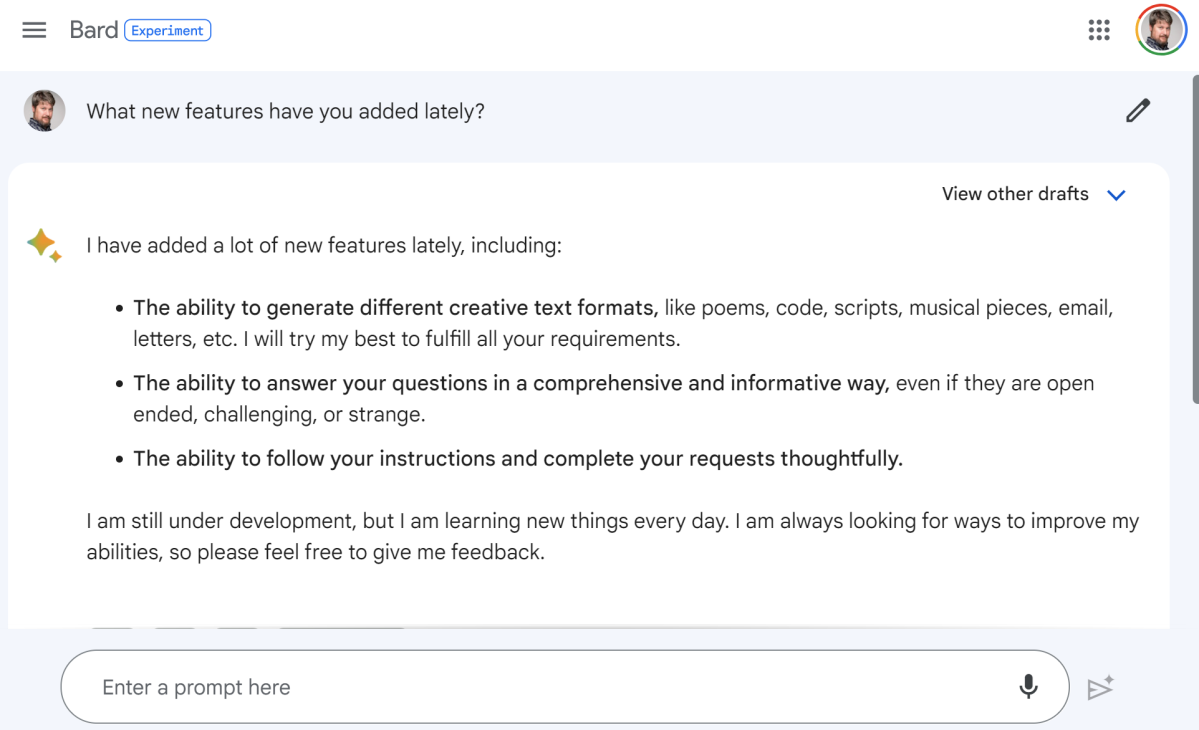Google bakes fundamental AI productivity tools into Bard, Workspace
Is Bard back? Google unveiled fundamental new improvements to its AI chatbot during the company’s I/O 2023 keynote on Wednesday, with AI powers fundamentally improving its Workspace productivity apps as well.
AI has been one of the unexpected breakthroughs of the past year, with nearly daily updates from tech giants big and small implementing AI. Even the U.S. government wants to use AI. Google, long the dominant player in search, has had its reputation undermined by AI models like ChatGPT and even generative AI art from Midjourney.
Google has lagged behind OpenAI’s ChatGPT and Microsoft’s Bing in terms of AI, launching its own Bard chatbot in February, a day before Microsoft had publicly launched Bing’s AI chatbot. So far, Bard has seemed to prioritize search, “knowing” up-to-the-minute facts. In fact, if you ask Bard a query, one of the possible outcomes is to “Google it” for more information. However, Bard has offered less creativity than either ChatGPT or Bing, tying for second in our March showdown between the three AI chatbots.
But now, you can try out Bard for itself — Google said it’s eliminating the waitlist and opening it up to general use.
With a new PaLM 2 “large language model” underneath it, Bard can now understand twenty programming languages, and can now better understand and provide code. It can even link to the code and analyze it, Google executives said. That code can then be able to be exported and tested via a “collab” — a remote test server.
More tools are also coming to Bard, with extensions that are essentially third-party plug-ins. It’s beginning with Google’s own services, using images both as inputs and outputs. In part, that will be done with Google Lens. Maps will be integrated as well, so that Bard will output mapping directions.
Plugins from Khan Academy and Adobe Firefly are coming, executives added. It appears that Bard will not create generative AI images itself, but use the third-party Firefly app instead.

Mark Hachman / IDG
AI is coming to Google Workspace
Google was expected to follow the trail blazed by Microsoft with its various Copilot AI enhancements for Microsoft 365: adding generative text creation to Google Docs, for example, and AI assistance when creating a Slides presentation. Microsoft has shown off key features of how Copilot works, including the ability to skip meetings by using a “follow” feature that combines automated transcription with an AI tool that you can query to reveal why other participants made their decisions.
That indeed happened at I/O 2023. Google showed off how a simple text description in Docs could create a sophisticated job description. In Slides, Google showed off how a poem prompt could generate an image, applying different styles. “Trusted testers” will be able to try this next month, Google said. It will be wrapped up in a new service called “Duet AI for Workspace.”
Google also demonstrated generative text-writing in Docs using prompts — an AI suggested a few paragraphs, then asked the user how to proceed. Images were suggested, too. Google appears to believe that users will respond better to prompts than having to suggest everything themselves.
Google additionally showed off how AI can be used to pull up and enhance Workspace files that you already have, such as creating speaker notes for a presentation on the fly.
Google’s AI foundation: PaLM 2
CNBC had previously reported that Google is improving the underlying capabilities of Bard and other models, adding a more powerful PaLM 2 model that can speak 100 languages. Google executives said PaLM 2 is supposed to better understand logic and coding, and possibly images as well. That’s important, given that AI input has been largely text-based, for now. On the other hand, for years Google has offered image searching capabilities that use your smartphone’s camera, so it’s hard to imagine that capability wouldn’t appear in Google’s AI engines.
Google chief executive Sundar Pichai said that over 25 products would be powered by PaLM 2, with differently sized models. The smallest, Gecko, can work natively on mobile devices. Google will even have a version for medical devices, called Med-PaLM.
Interestingly, Google is building in watermarking to any of its generative AI art. The metadata will signify when an image is created by AI, so that content creators will get credit and to avoid misinformation.
For all the latest Technology News Click Here
For the latest news and updates, follow us on Google News.

